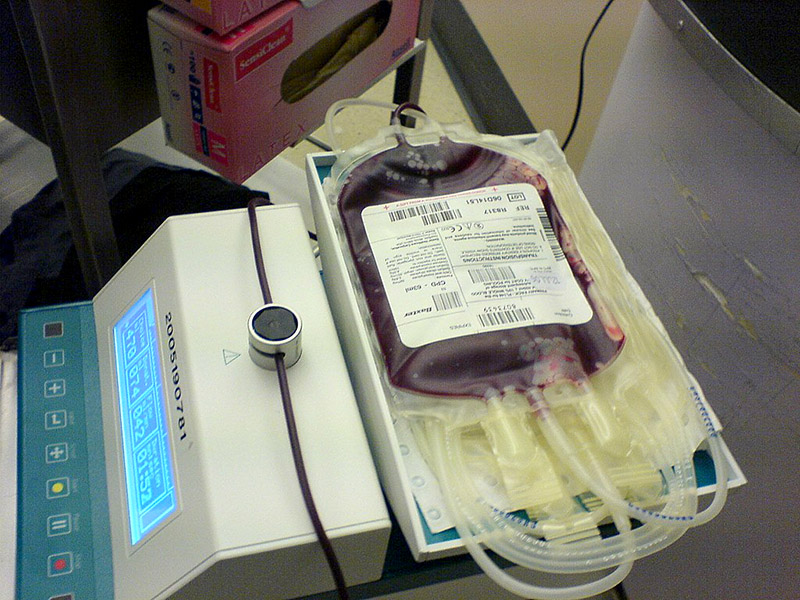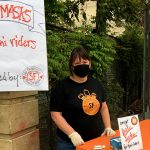As the number of coronavirus cases mounts, health care professionals are anticipating another crisis: a blood shortage. Nationally, the Red Cross estimates someone needs blood every two seconds, and around 80% of the American Red Cross’ donation sites have shut down under social-distancing and shelter-in-place protocols.
The majority of the Red Cross’ blood in Northern California is collected through mobile drives at schools, businesses, churches and other community locales, which have suspended operations, said Theresa Evangelista, a senior account manager for the American Red Cross Blood Services. Since the beginning of the outbreak, she said, the region has seen 118 blood drives canceled, which has left some 3,863 units of blood not collected.
“We always assume it’s back there, that we can get blood when we need it. And it’s not something we’re really thinking about. But in fact, there’s a tremendous amount of work behind the scenes taking place to make that possible,” said Dr. Coco Auerswald, a physician and instructor at the UC Berkeley-UCSF Joint Medical Program. Auerswald also co-directs the Community Action Team at the Berkeley School of Public Health responding to the COVID-19 crisis.
“When there are fewer places to donate blood, and there are fewer people donating blood, then you can have a really severe shortage,” Auerswald said.
Exactly that is impending. Phoebe Miller, a third-year medical student at the joint medical program and Auerswald’s former student, is not learning in hospitals at the moment because of the shelter-in-place order. But she has been keeping an eye out for ways to support already stretched medical staff, and word came that practitioners are seeing a problem brewing.
“I first learned about it from the surgery resident that I had just been working with, who emailed our group to say, like, ‘Hey, if you guys have some free time, this is what’s happening in the hospitals: We’re running low on blood,’” Miller said.
Students responded by beginning to arrange blood drives. Drives are scheduled to take place April 1-3 at the Millberry Union Gymnasium at the UCSF Parnassus campus and April 7-9 at the conference center at UCSF Mission Bay. A drive at UC Berkeley is pending.
But these, like everything else, are complicated by social distancing mandates. Among the challenges that organizers face is the sheer space needed to set up a donation center, since all beds and intake stations for donors must now be spaced six feet apart. Miller said students are looking for spaces with at least six grounded power outlets, space to unload a truck and and measuring 1,000 square feet. Miller encouraged anyone who knows of such locations in the East Bay to reach out directly to the American Red Cross, Vitalant or to her directly.
That space requirement is several times the required area for a normal donation center but, with social distancing, offers no increase in capacity. Around 25 people a day can donate in such a space, far from enough to fill the need.
“We need a lot of these large spaces,” Auerswald said. “It’s really critical.”
Also critical are donors themselves.
“One of the most important things you can do to ensure we don’t have another health care crisis on top of coronavirus is make an appointment to donate,” urges the American Red Cross website.
Auerswald and Evangelista emphasized that donating blood – and receiving it – is safe. There is no record of transmissions of coronavirus through blood, and Auerswald said the virus has been found in blood samples so rarely, and at such low concentrations, that there is no reason to believe blood would be infectious.
For donors and staff, the Red Cross is taking additional measures to minimize the risk of transmission. Aside from spacing donors at social distancing minimums in donation centers, each potential donor is also subjected to a temperature screening. If they show an elevated temperature, they are turned away. Staff have always worn gloves when they touch patients, but additional disinfecting measures are being taken. Those at higher risk for complications of COVID-19, like seniors or those with a compromised immune system or lung or heart diseases, are not being asked to donate blood.
“I would personally feel fine donating blood myself right now, I would be fine having my daughters donate blood,” Auerswald said. “If I had a high-risk family member, I’d say, ‘Hey, you know what, let the rest of us do this right now, you don’t need to.’”
As organizers scramble to get donations back up and running, it may seem as though there are few opportunities to give. But Evangelista urged those willing to donate to keep trying.
“There still is a need, even if they don’t see an available appointment. They’re welcome to also come as a walk-in, to stop by the drive to see if we can accommodate them,” she said. “Even if they’re saying no appointment slots, it doesn’t mean that they’re not needed. So we’re working hard on trying to get more drives on the calendar.”
Potential donors may review eligibility requirements to give blood on the Red Cross website or by calling its eligibility hotline: 1-866-236-3276. Appointments to give blood can also be made online with the Red Cross or with Vitalant (donors should try again later if there are no slots available immediately) or by calling 1-800-RED-CROSS.
A segment from our radio show, “Civic.” Listen daily at 8 a.m. and 6 p.m. on 102.5 FM in San Francisco.










